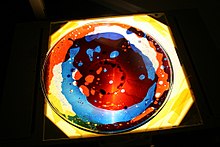Space rock is a music genre characterized by loose and lengthy song structures centered on instrumental textures that typically produce a hypnotic, otherworldly sound. It may feature distorted and reverberation-laden guitars, minimal drumming, languid vocals, synthesizers, and lyrical themes of outer space and science fiction.

The Fillmore is a historic music venue in San Francisco, California.

More is the third studio album and first soundtrack album by English rock band Pink Floyd. It was released on 13 June 1969 in the United Kingdom by EMI Columbia and on 9 August 1969 in the United States by Tower Records. The soundtrack is for the film of the same name, which was primarily filmed on location on Ibiza and was the directorial debut of Barbet Schroeder. It was the band's first album without former leader Syd Barrett.

The UFO Club was a short-lived British counter-culture nightclub in London in the 1960s. The club was established by Joe Boyd and John "Hoppy" Hopkins. It featured light shows, poetry readings, well-known rock acts such as Jimi Hendrix, avant-garde art by Yoko Ono, as well as local house bands, such as Pink Floyd and Soft Machine. The club operated for the nine months from December 1966 to August 1967, and an additional seven months at 31 Tottenham Court Road in Fitzrovia, followed by a further two months at the Roundhouse in Chalk Farm.
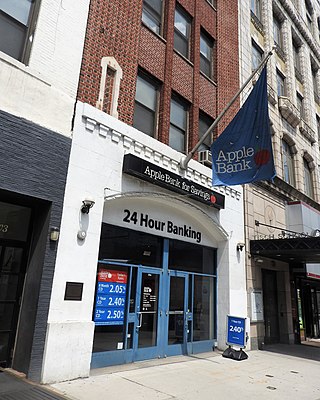
The Fillmore East was rock promoter Bill Graham's rock venue on Second Avenue near East 6th Street on the Lower East Side section of Manhattan, now called the East Village, in New York City. The venue was open from March 8, 1968, to June 27, 1971, and featured some of the biggest acts in rock music of that time. The Fillmore East was a companion to Graham's Fillmore Auditorium, and its successor, the Fillmore West, in San Francisco.

Psychedelic art is art, graphics or visual displays related to or inspired by psychedelic experiences and hallucinations known to follow the ingestion of psychedelic drugs such as LSD, psilocybin, and DMT. The word "psychedelic" means "mind manifesting". By that definition, all artistic efforts to depict the inner world of the psyche may be considered "psychedelic".
"Several Species of Small Furry Animals Gathered Together in a Cave and Grooving with a Pict" is a track written and performed by Roger Waters from the 1969 Pink Floyd double album, Ummagumma.

"See Emily Play" is a song by the English rock band Pink Floyd, released as their second single on 16 June 1967 on the Columbia label. Written by original frontman Syd Barrett, it was released as a non-album single, but appeared as the opening track of Pink Floyd, the US edition of the band's debut album The Piper at the Gates of Dawn (1967).

The discography of the English rock group Pink Floyd consists of 15 studio albums, six live albums, 12 compilation albums, five box sets, three EPs, and 27 singles. Formed in 1965, Pink Floyd earned recognition for their psychedelic or space rock music, and, later, their progressive rock music. The group have sold over 250 million records worldwide, including 75 million in the United States.
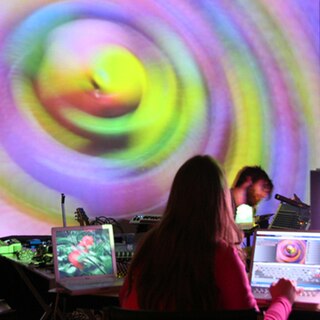
VJing is a broad designation for realtime visual performance. Characteristics of VJing are the creation or manipulation of imagery in realtime through technological mediation and for an audience, in synchronization to music. VJing often takes place at events such as concerts, nightclubs, music festivals and sometimes in combination with other performative arts. This results in a live multimedia performance that can include music, actors and dancers. The term VJing became popular in its association with MTV's Video Jockey but its origins date back to the New York club scene of the 1970s. In both situations VJing is the manipulation or selection of visuals, the same way DJing is a selection and manipulation of audio.

The Avalon Ballroom was a music venue in the Polk Gulch neighborhood of San Francisco, California, at 1244 Sutter Street. The space is known as the location of many concerts of the counterculture movement, from around 1966 to 1969. It also had a reopening 34 years later, from 2003 to 2005.

USCO was an American media art collective in the 1960s, founded by Gerd Stern, Michael Callahan, Steve Durkee, Judi Stern, and Barbara Durkee in New York. The name USCO is an acronym for Us Company or the Company of Us. The collective was most active during the years 1964–66. USCO exhibited in the United States, Canada, and Europe, and is considered a key link in the development of expanded cinema, visual music, installation art, multimedia, intermedia, and the Internet. In addition, USCO's strobe environments heralded new media art.
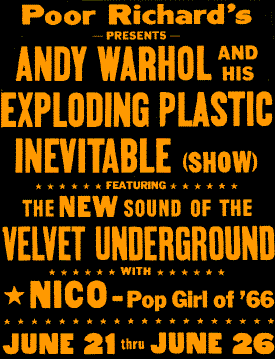
The Exploding Plastic Inevitable, sometimes simply called Plastic Inevitable or EPI, was a series of multimedia events organized by Andy Warhol in 1966 and 1967, featuring musical performances by The Velvet Underground and Nico, screenings of Warhol's films, and dancing and performances by regulars of Warhol's Factory, especially Mary Woronov and Gerard Malanga. Andy Warhol's Exploding Plastic Inevitable is also the title of an 18-minute film by Ronald Nameth with recordings from one week of performances of the shows which were filmed in Chicago, Illinois, in 1966. In December 1966 Warhol included a one-off magazine called The Plastic Exploding Inevitable as part of the Aspen No. 3 package.

The Acid Tests were a series of parties held by author Ken Kesey primarily in the San Francisco Bay Area during the mid-1960s, centered on the use of and advocacy for the psychedelic drug LSD, commonly known as "acid". LSD was not made illegal in California until October 6, 1966.
The hippie subculture began its development as a youth movement in the United States during the early 1960s and then developed around the world.
The Joshua Light Show, created by Joshua White, was a liquid light show. It was known for its psychedelic art and served as a lighting backdrop behind many live band performances during the late 1960s and early 1970s.
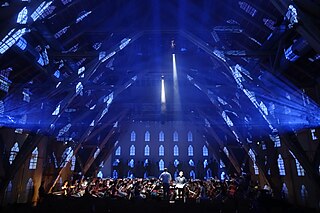
Video design or projection design is a creative field of stagecraft. It is concerned with the creation and integration of film, motion graphics and live camera feed into the fields of theatre, opera, dance, fashion shows, concerts and other live events. Video design has only recently gained recognition as a separate creative field. For instance, United Scenic Artists' Local 829, the union representing designers and scenic artists in the US entertainment industry, only added the Global Projection Designer membership category in 2007. Prior to this, the responsibilities of video design would often be taken on by a scenic designer or lighting designer. A person who practices the art of video design is often known as a Video Designer. However, naming conventions vary worldwide, so practitioners may also be credited as Projection Designer, "Media Designer", Cinematographer or Video Director. As a relatively new field of stagecraft, practitioners create their own definitions, rules and techniques.
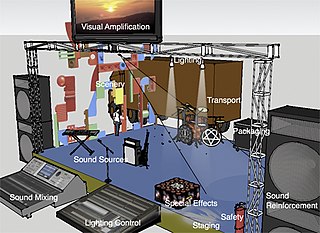
Live event support includes staging, scenery, mechanicals, sound, lighting, video, special effects, transport, packaging, communications, costume and makeup for live performance events including theater, music, dance, and opera. They all share the same goal: to convince live audience members that there is no better place that they could be at the moment. This is achieved through establishing a bond between performer and audience. Live performance events tend to use visual scenery, lighting, costume amplification and a shorter history of visual projection and sound amplification reinforcement.
Joan Hills is an artist born in Edinburgh, Scotland in 1931. She lives in London.
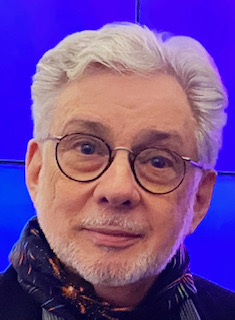
Joshua White is an American artist, video maker and broadcast television director. Best known for The Joshua Light Show, a 1960s and 1970s liquid light show, his work is in the permanent collection of the Museum of Modern Art in New York and has been exhibited at Museum of Contemporary Art, Los Angeles, the Whitney Museum of American Art, the Hirshhorn Museum, the New Museum, the Hayden Planetarium, the Barbican Center in London, the Centre Pompidou in Paris, The Broad Museum in Los Angeles, and the New-York Historical Society as well as many other venues.

